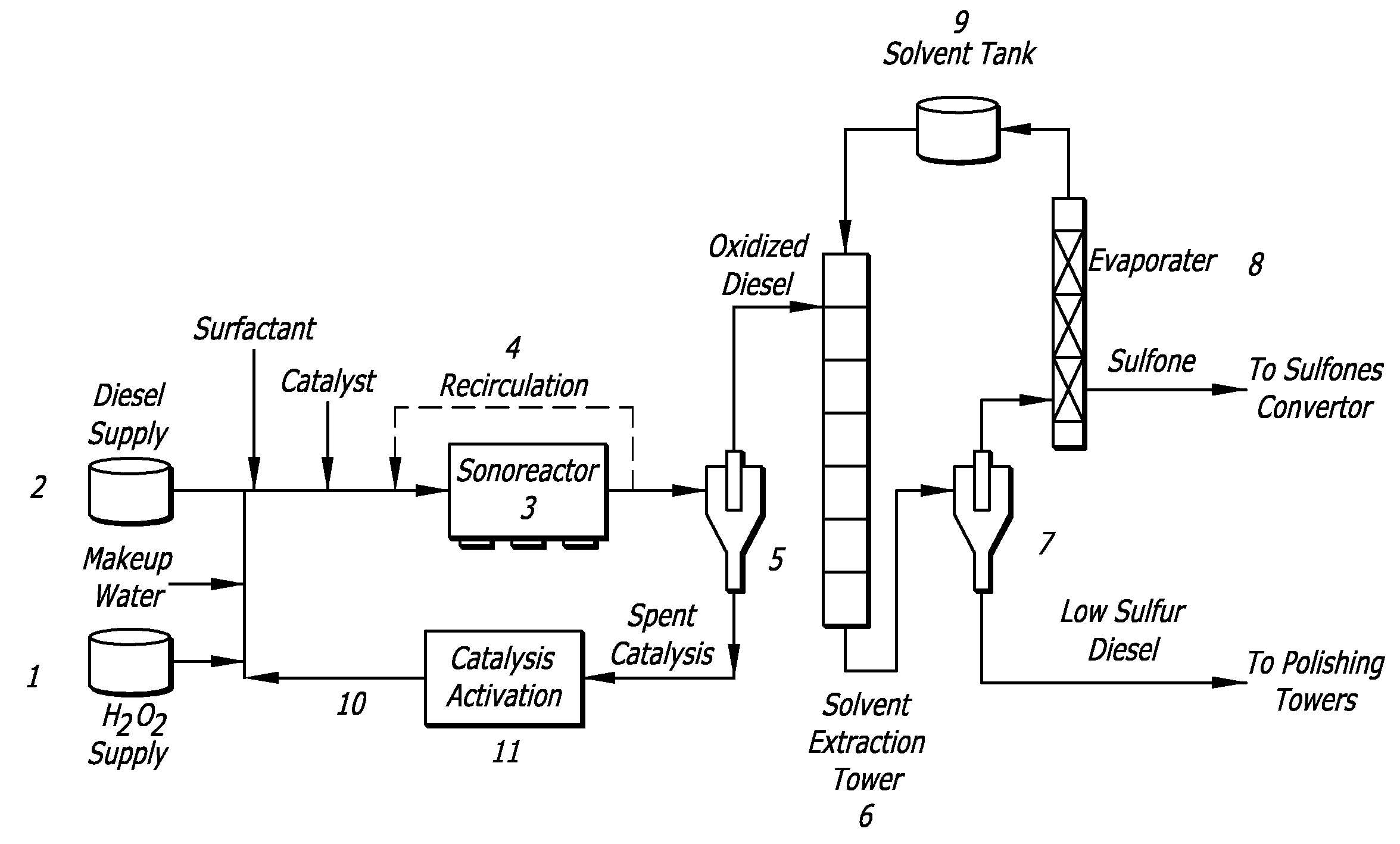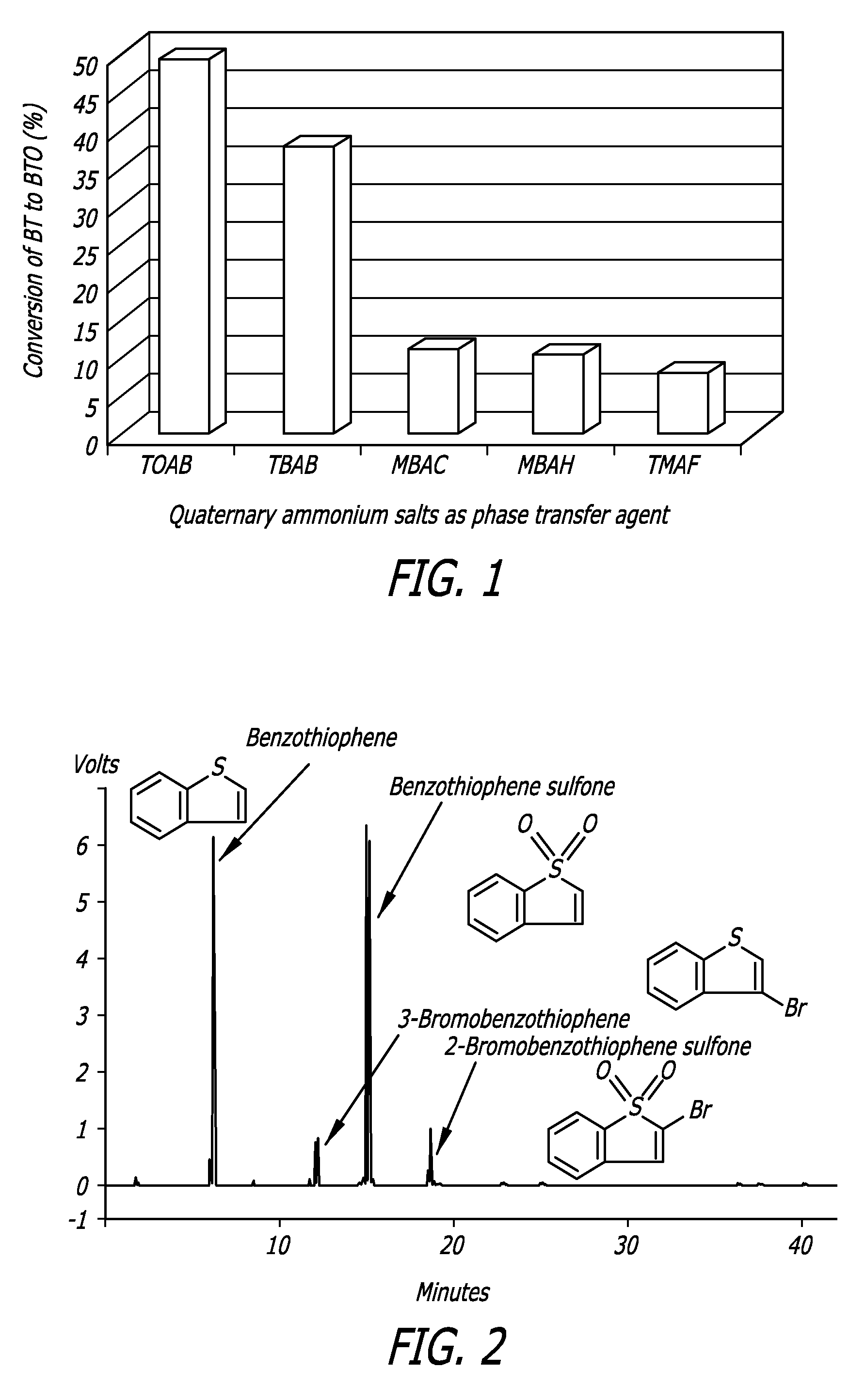Ultrasound-Assisted Oxidative Desulfurization of Diesel Fuel Using Quaternary Ammonium Fluoride and Portable Unit for Ultrasound-Assisted Oxidative Desulfurization
a technology of quaternary ammonium fluoride and desulfurization, which is applied in the direction of fuels, energy-based chemical/physical/physicochemical processes, mechanical vibration separation, etc., can solve the problems of air pollution, corroding parts of internal combustion engines, and affecting the efficiency of diesel fuel combustion, so as to enhance the progress of the reaction and maintain control over the reaction , the effect of intense mixing
- Summary
- Abstract
- Description
- Claims
- Application Information
AI Technical Summary
Benefits of technology
Problems solved by technology
Method used
Image
Examples
example 1
[0074]In this example, model compounds were reacted under UAOD reaction conditions. Table 1 shows the oxidation of BT to BTO, which proceeds at very low or high reaction rate in presence of surface-active agents using quaternary ammonium salts (QAS) as cationic surfactants. The data indicates that an effective oxidant in the reaction system is in the form of peroxo metal anion and cationic surfactants; the QAS especially can function as a phase transfer agent and deliver the anion into organic phase or interfacial region, thus facilitating the oxidation of organic sulfur compounds.
TABLE 1EFFECT OF DIFFERENT TYPES OF SURFACTANTS ONUAOD PROCESSTypeSurfactantDesulfurizationCationicTetraoctylammonium Bromide (TOAB)+Tetrabutylammonium Bromide (TBAB)+Methyltributylammonium Chloride (MBAC)+Methyltributylammonium Hydroxide+(MBAH)Tetramethylammonium Fluoride (TMAF)+Anionic1-Octanesulfonic Acid, Sodium Salt−NonionicTween 80−ControlNo Surfactant−Aside:+ indicates that there is reaction occurri...
example 2
[0076]This example illustrates the problems associated with the use of brominated QAS compounds as PTCs. Sample compounds were reacted under UAOD conditions. FIG. 2 shows that there were three sulfur products left in the desulfurized BT solution after using TAOB as PTA under UAOD conditions. Based on the retention time, these three sulfur compounds were categorized as BTO, 3-bromobenzothiophene and 2-bromobenzothiphene sulfone. This example illustrates how bromination is caused by the bromide anion of the QAS used as PTA.
example 3
[0077]These examples illustrate the effectiveness of one UAOD process of the present disclosure and to determine the relative reactivity of various phase transfer agents and the superiority of TAOF as a PTA.
[0078]The data in FIG. 3 illustrates the comparison of reaction yields of different quaternary ammonium salts used in this example to convert the BT to BTO. In this example, compounds were sonicated for 10 minutes. TOAF exhibited the highest yield. Again, the data also illustrate how increasing the alkyl chain length of the substituents in addition to using a fluoride anion in the PTC has a positive effect on the yield.
[0079]FIG. 4 illustrates how the BT to BTO conversion by use with TOAF as the PTA is further improved to 97.53% upon 20 minute reaction time. As is shown, the spectra are free of any brominated by-products.
[0080]FIG. 5 indicates the results of 2M-BT by using the TAOF as PTA. The brominated compounds are not formed when TOAF is used as the PTA, whereas with TAOB as ...
PUM
| Property | Measurement | Unit |
|---|---|---|
| temperature | aaaaa | aaaaa |
| temperature | aaaaa | aaaaa |
| frequency | aaaaa | aaaaa |
Abstract
Description
Claims
Application Information
 Login to View More
Login to View More - R&D
- Intellectual Property
- Life Sciences
- Materials
- Tech Scout
- Unparalleled Data Quality
- Higher Quality Content
- 60% Fewer Hallucinations
Browse by: Latest US Patents, China's latest patents, Technical Efficacy Thesaurus, Application Domain, Technology Topic, Popular Technical Reports.
© 2025 PatSnap. All rights reserved.Legal|Privacy policy|Modern Slavery Act Transparency Statement|Sitemap|About US| Contact US: help@patsnap.com



